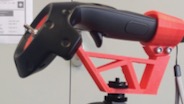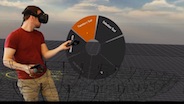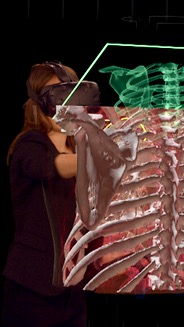 |
Mixed Reality Experience - A brief introduction to VR using a Virtual (TV) Studio [DE]
The production with the title "Mixed Reality Experience - A brief introduction to VR using a Virtual (TV) Studio" was part of the master course module "Interactive Virtual Studio" at the HS Düsseldorf, University of Applied Sciences and took place at the Studio from vr3 / Voss GmbH – TV Ateliers.
The idea for the production was inspired by the interview and demonstration at the public TV program "WDR Lokalzeit" at 10.11.2016 with the title "Willkommen im Virtual Reality-Café". The goal was to use a virtual tv studio, enabling egocentric and exocentric views within the virtual environment.
The set shows a part of the SteamVR application "The Lab", demonstrating interaction and navigation. A brief introduction to VR defined by imagination, immersion and interaction is given. The shown composition of real and virtual objects is called "Augmented Virtuality". The actors demonstrate the possibilities of interaction by playing with balloons and moving a cutting plane through a medical human scan.
The camera tracking system Startracker (Mo-Sys) was used with the Tracking Hub (Vizrt) software using an OpenVR driver, enabling the production without modifying the VR application.
The hardware keyer from Ultimatte was used for image processing such as removing the background and mixing.
The question “How can the experience or use of a virtual environment be shown to a third party using a live stream or recording?” was the main focus.
Video
The media player is loading...
Keywords
Virtual Studio, HMD, Vive, Interaction
Download
| Description | Time | mp4 |
| Original 1080p mobil | 5:53 Min | 270,4 MB >> |
| Shinpei Takeda: Atomic Morphology (VR) 720p mobil | 3:20 Min | 256,6 MB >> |
| Shinpei Takeda paints in VR for the first time 720p mobil | 2:23 Min | 150 MB >> |
A brief introduction to VR using a Virtual (TV) Studio Production
Actors: Bianca Herder, Ida Kiefer
Team:
Florian Busch, Jens Herder, Dennis Hergert, Sebastian Holthausen, Kevin Klever, Dirk Konopatzki (vr3), Philipp Ladwig, Antje Müller, Jochen Schreiber (vr3), Kai Vermeegen
Credits
- Tracking Hub Software from Vizrt
- Camera tracking system - StarTracker from Mo-sys
- Virtual studio vr3 / Voss GmbH – TV Ateliers
- VR software for a demonstration: The Lab von Valve
Shinpei Takeda: Atomic Morphology (VR)
Artist: Shinpei Takeda
Team:
Jens Herder, Sebastian Holthausen, Antje Müller, Felix Paul, Kai Vermeegen
Credits
- Tracking Hub Software from Vizrt
- Camera tracking system - Egripment/Trackmen
- Virtual studio at the HSD
- VR software for a drawing: Google Tilt Brush
Adapter for Vive Controller
 
For first experimental shots, an adapter was designed by Denis Hergert and 3d printed. The model of the adapter can be used freely, but fits only for one version of the vive controller. The video clip for the master thesis Advantages and Limitations of Immersive 3D Polygonal Mesh Modelling in Virtual Reality from Philipp Ladwig was produced with a similar technique.
Productions
- Interactive Virtual Studio - Indiana Jones in the Land of Students
- Production at the HS Düsseldorf, University of Applied Sciences with the game engine Unreal, 2018.
- Exercise Virtual Studio [2016] with the topic VR
- Students learn studio operation at exercises to the class Virtual Studio within the bachelor program Media Engineering.
- Subtle Animations using Talent Tracking in a Virtual (TV) Studio
- Production at the Virtual Studio FH Düsseldorf in 2014.
- SpiderFeedback - Rope-based, visual feedback for orientation in Virtual Studios
- Production at the Virtual Studio FH Düsseldorf in 2014.
- VRON: Virtual Reality over Networks - Four Metamorphosis states in a distributed virtual (tv) studio: Human, cyborg, avatar, and bot
- Production at the Virtual Studio FH Düsseldorf in 2013.
- Markerloses Darsteller Tracking für Anwendungen im Virtuellen Studio
- Production at the Virtual Studio FH Düsseldorf in 2013.
Publications
- A Lighthouse-based Camera Tracking System for Professional Virtual Studios
- Kai Vermeegen and Jens Herder, GI-VRAR, Workshop Proceedings / Tagungsband: Virtuelle und Erweiterte Realität – 15. Workshop der GI-Fachgruppe VR/AR, ISBN 978-3-8440-6215-1, Düsseldorf, pp. 19-26, October, 2018.
- Mixed Reality Experience - How to Use a Virtual (TV) Studio for Demonstration of Virtual Reality Applications
- Jens Herder, Philipp Ladwig, Kai Vermeegen, Dennis Hergert, Florian Busch, Kevin Klever, Sebastian Holthausen, and Bektur Ryskeldiev, Proceedings of the 13th International Joint Conference on Computer Vision, Imaging and Computer Graphics Theory and Applications - Volume 1: GRAPP, Santa Cruz, Portugal, INSTICC, DOI=10.5220/0006637502810287, Januar 27-29, 2018.
- Four Metamorphosis States in a Distributed Virtual (TV) Studio: Human, Cyborg, Avatar, and Bot - Markerless Tracking and Feedback for Realtime Animation Control
- Jens Herder, Jeff Daemen, Peter Haufs-Brusberg, Isis Abdel Aziz. Four Metamorphosis States in a Distributed Virtual (TV) Studio: Human, Cyborg, Avatar, and Bot - Markerless Tracking and Feedback for Realtime Animation Control, In Virtual Realities, pp 16-32, Springer International Publishing, DOI=10.1007/978-3-319-17043-5_2, ISBN 978-3-319-17042-8, April 1st, 2015.
- SpiderFeedback - Visual feedback for Orientation in Virtual TV Studios
- Jonathan Simsch and Jens Herder, 11th International Conference on Advances in Computer Entertainment, ACE 2014, Funchal, Portugal, November 11-14, 2014.
- Four Metamorphosis States in a Distributed Virtual (TV) Studio: Human, Cyborg, Avatar, and Bot
- Jose Burga, Jeff Daemen, Sascha Charlie Djuderija, Maren Gnehr, Lars Goossens, Sven Hartz, Peter Haufs-Brusberg, Jens Herder, Mohammed Ibrahim, Nikolas Koop, Christophe Leske, Laurid Meyer, Antje Müller, Björn Salgert, Richard Schroeder, and Simon Thiele, 10th International Conference on Visual Media Production (CVMP 2013), short paper, London, November, 2013.
- Markerless Actor Tracking for Virtual (TV) Studio Applications
- Jeff Daemen, Peter Haufs-Brusberg, and Jens Herder, International Joint Conference on Awareness Science and Technology & Uni-Media Computing (iCAST 2013 & UMEDIA 2013), HC-2013 Track, Hamamatsu/Aizu-Wakamatsu/Duesseldorf, November, 2013.
Bachelor and Master theses
- Advantages and Limitations of Immersive 3D Polygonal Mesh Modelling in Virtual Reality
- Philipp Ladwig, Master thesis, 12.5.2017
|
 |
